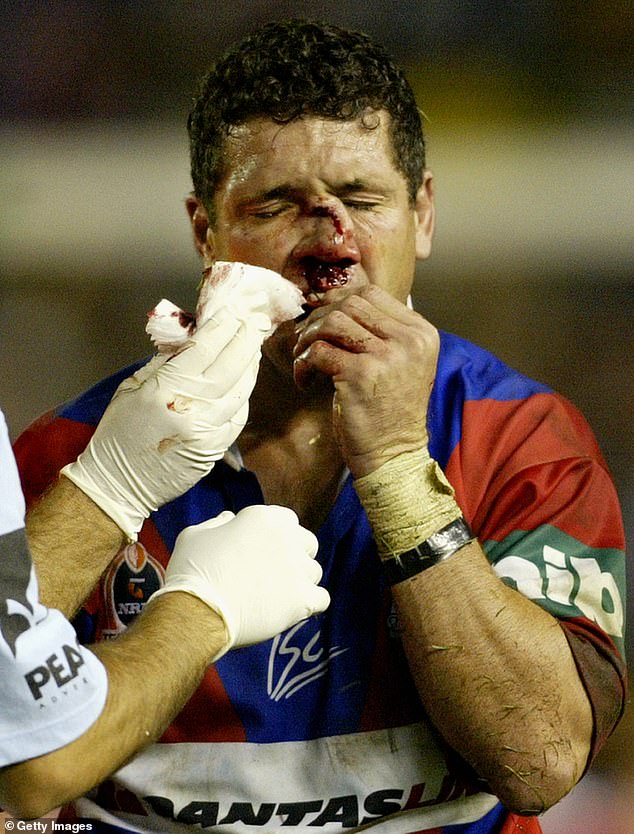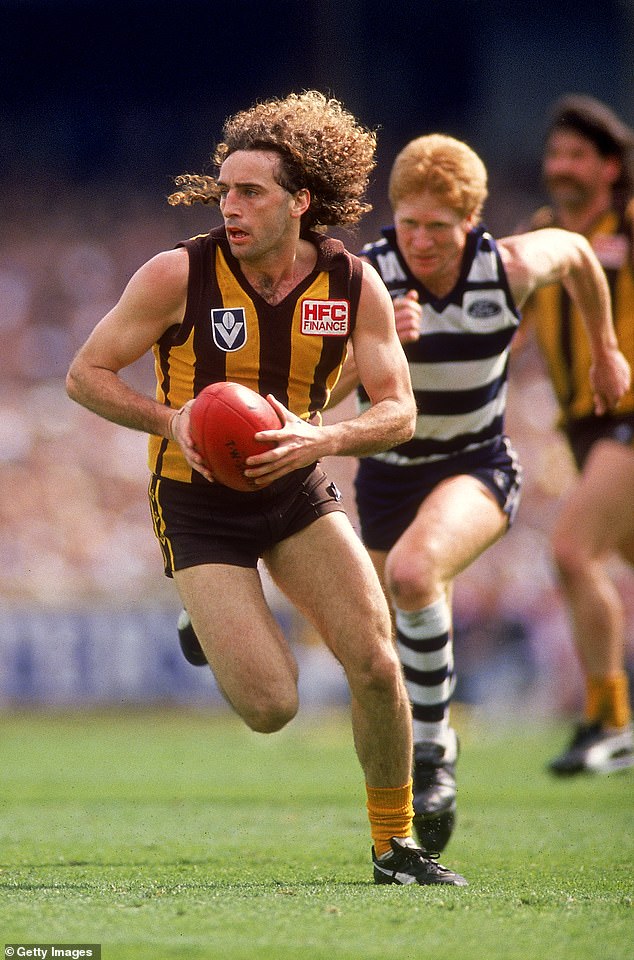Robbie O’Davis: Footy star suffering CTE reveals darkest moment perched on top of cliff after drinking 24 beers – as new push is launched to help players battling brain injury
NRL legend Robbie O’Davis has revealed the heartbreaking moment he almost took his own life before understanding the impact of an undiagnosed brain injury from his fearless playing days.
O’Davis, now 50, nearly jumped off a cliff while drinking an entire case of 24 beers, throwing the empty bottles over the side and watching them shatter on the rocks.
“I was sitting on the edge drinking a pack of beer and I threw one over the edge and I looked at it and it broke and I was like, ‘I’m following it,’” he told 7News Spotlight. Sunday.
Things got so bad for the two-time premiership-winning Newcastle Knights speedster that he performed the same grim cliff ritual six times.
Every time he considered taking his own life, he thought of his teenage son and daughter, which discouraged him from going through with it.
Robbie O’Davis with wife Louise, who is part of a support group for footy wives and girlfriends whose partners have been affected by CTE
“You don’t want to lose a father,” said his tearful daughter Dior O’Davis, 15.
‘He’s my best friend, he’s my protector. It’s hard to hear all these things.’
The sad reason it took Robbie O’Davis years to get help after his 223-game career is because he was afraid of getting in trouble for throwing trash off the cliff.
O’Davis did not know at the time that his mood swings and depression were symptoms of chronic traumatic encephalopathy (CTE).
It is a progressive brain disease associated with repetitive traumatic brain injury, dementia and ultimately premature death.
He was diagnosed with CTE in April by Dr Rowena Mobbs, Australia’s leading CTE doctor.
Reflecting on his career, which saw him represent Queensland and Australia, O’Davis said his height – just 172cm tall – likely left him vulnerable as he regularly tried to avoid tackles ‘at forearm level’.
Although stricter rules are now in place to protect players who have suffered head knocks, that does not help the long-retired legends of the game.
Robbie O’Davis’ wife Louise said while his diagnosis was well known in rugby league circles, neither had been contacted by the NRL.

The former Knights speedster, who played 223 NRL games, became so depressed by CTE that he considered taking his own life six times. Pictured: Robbie O’Davis after suffering a horrific injury a year before his retirement in 2004
Ms. O’Davis broke down at a support group for wives and girlfriends dealing with the effects of their partners’ progressive CTE.
“He has one of the worst brain scans (Ms Mobbs) has ever seen,” Ms O’Davis said.
But in a significant development, the NRL has now established the Life After Football Foundation to fund medical expenses such as the cost of an annual brain scan for ex-players.
The disease is strongly associated with athletes who suffer repeated blows to the head and especially concussions.
Former rugby league, Aussie Rules and rugby union players have been diagnosed, as well as many other contact sports around the world.
O’Davis is one of several high-profile former stars leading ongoing campaigns to obtain key codes to help former players
John Platten, an AFL hall-of-famer who won four premierships and was the 1987 Brownlow Medalist, is another CTE sufferer.
He suffered no fewer than 40 concussions during a stellar 18-year career.

John Platten, an AFL hall-of-famer who won four premierships and was the 1987 Brownlow Medalist, is another CTE sufferer

Platten suffered a shocking 40 concussions during his glittering Aussie Rules playing career
Platten told 7News he could not remember winning the 1989 VFL grand final in which he suffered concussion.
In an emotional scene, Platten looked at his brain scans and asked how he could get better.
Dr. Mobbs, chief medical officer for Connectors Australiaa charity that supports people with CTE and their loved ones, explained to a tearful Platten that he would not get better.
‘I really hope that I’m wrong and that there is a change in these scans and in you.’
A Melbourne law firm, Margalit Injury Lawyers, is pursuing a class action on behalf of all former AFL players who suffered head injuries between 1985 and 2023.
The company’s director, Michel Margalit, wants CTE to be treated as a workplace injury, noting that football players are excluded from work cover ‘nationally’.
For free mental health support, call Lifeline Australia: 13 11 14
